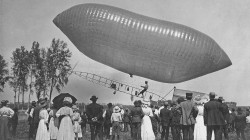Culture | March 7th, 2016

Who would have thought that what started out as a concept for a halloween radio stunt in 2003, would lead to thousands of miles travelled, hundreds of towns visited, and five books worth of material. “Ghosts of North Dakota” photographer, author, and webmaster Troy Larson can’t believe it either.
The initial idea was that he and GND partner Terry Hinnenkamp (who both worked in radio at the time), stay in an abandoned place for the night, the concept involved a “House on Haunted Hill” idea in which they would broadcast live from wherever they happened to end up. Much research was done but it never came to fruition. Though their research was not in vain. In the process, they realized that they had a shared interest in ghost towns and abandoned structures.
A few weeks later with camera in hand they hit the road to Steele county and found themselves exploring Sherbrooke North Dakota --a bonafide ghost town.Larson submitted a few photographs to a ghost town website that featured images from across the nation. Once he received no response and didn’t see the photos posted, he created his own website with his basic knowledge of HTML. This website is now known as“Ghosts of North Dakota”. Once Hinnenkamp plugged it on KFGO emails started to pour in full of comments and suggestions.
Along with follower suggestions, Larson and Hinnenkamp find their locations via old railroad maps and google earth. Each site is extensively researched, Larson and Hinnenkamp serve as roadside historians with a mission to document these prairie towns via photograph before they disappear.”I think that’s why we have as many followers as we have, because nobody really does this”, Larson says, “ It’s easy to drive down the interstate at this time of year and see brown flat landscapes--and go, well that’s boring, but the second you get out into it and explore it with a camera, you think, whoa--this is pretty cool. There’s cool stuff to see when you’re not racing by at 70 miles per hour”.
Larson and Hinnenkamp’s creeds are, “Take only photos, leave only footprints”, stay on public roads, and “when in doubt stay out”. Larson admits that they’ve been chased off of properties on multiple occasions, and have even been threatened to be shot. “Sometimes it’s a margin call, one philosophy [on trespassing] states that every piece of property belongs to someone so you should ask permission before you take any photos, so there’s that ethos or right extreme”, Larson explains, “and then on the other side of it, take pictures of everything and if no one says anything, no harm no foul. We’re always trying to figure some way in the middle”.
Larson’s latest project is a 128 page book titled, “Fargo Moorhead Lost and Found” it is a collection of vintage photographs, postcards, and local lore. Larson had the idea years ago. He said it was something he had always wanted to do, but the initial idea was to create a similar book on the entire state. He and Hinnenkamp were collecting photographs and postcards, but they noticed they had a large collection of Fargo stuff and the ball for “Fargo Moorhead Lost and Found” started rolling.
Larson also came across some Farm Security Administration photographs from the 1930s and 40s on the Library of Congress website. The FSA sent a crew of photographers to photograph large sections of North Dakota during the dustbowl era as part of the New Deal to document the plight of impoverished families in rural areas. The men that photographed our state were Arthur Rothstein, Russel Lee, and John Vachon. Not only did they photograph a lot of western North Dakota, there were a considerable amount of photos of Fargo
“When I discovered these images I started clicking away and found places I knew right away.” Larson said. Those images along with the postcard images are then coupled with contemporary images are included on the companion website in which there is a plug-in for a “now and then” effect.
What Larson found most fascinating in regard to his Fargo Moorhead research is the fact that the majority of the original buildings in Moorhead no longer exist. “There’s a couple block span where the Center Mall and City Hall are, there’s a whole downtown there that no one knows about unless you are a certain age”, Larson says, “ it was in keeping with the urban renewal practices of the day, that you knock down all the old buildings and build a mall because that’s what everyone wants. I understand why they have to do it sometimes, but I wish they would minimize it as much as they could because the architecture is a treasure.”
YOU SHOULD KNOW:
December 18th 2025
October 20th 2025
October 15th 2025
September 16th 2025
July 29th 2025



_(1)_(1)_(1)_(1)__293px-wide.jpg)
__293px-wide.jpg)
__293px-wide.jpg)